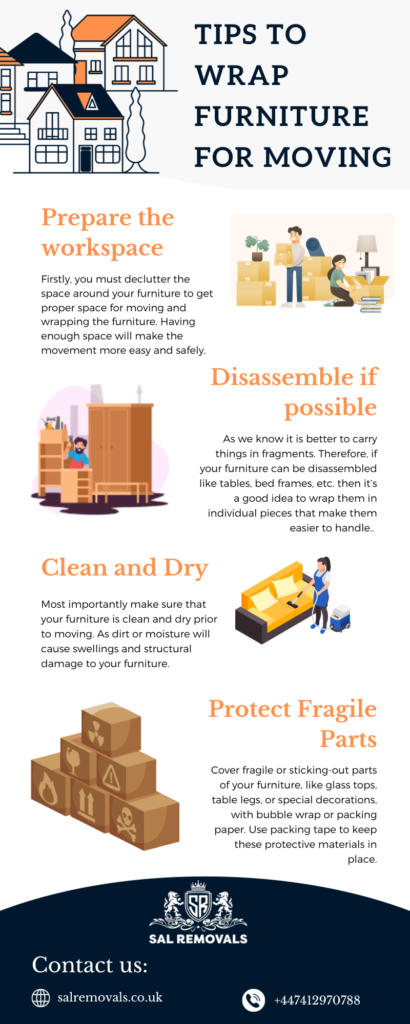Moving to a new house is a little bit stressful especially when it comes to moving your furniture from one place to another. The most underrated thing during moving is furniture that needs to be taken care of. No matter whether you are moving far or near, it is necessary to make sure your furniture doesn’t get damaged during the move. One little mistake may damage your furniture leading to a high cost or sometimes you are carrying your antique items that need to be protected.
This is where top-rated furniture removal and storage companies come into play that need to be chosen with comprehensive research based on customer feedback, trustworthiness, and many other factors. But, there might be several scenarios why you have to pack your furniture on your own without the help of experts.
Therefore taking all of these into consideration we’ll help you figure out the moving checklist to pack furniture for moving in an easier and less stressful way.
Materials you’ll need to Pack Furniture for Moving:
- Moving blankets or furniture pads
- Bubble wrap or packing paper
- Plastic wrap (stretch wrap)
- Packing tape
- Furniture sliders (optional)
Tips to Wrap Furniture for Moving
Wrapping your furniture is the most necessary part of moving your furniture. To protect furniture from heavy damage, the right form of packaging is necessary. Well, you can also take the help of furniture removal and storage for moving large furniture. As we have discussed above the kind of material you could choose for furniture moving, now here we’ll show you a step-by-step guide on how to wrap furniture for moving:
Step 1: Prepare the workspace
Firstly, you must declutter the space around your furniture to get proper space for moving and wrapping the furniture. Having enough space will make the movement more easy and safely.
Step 2: Disassemble if possible
As we know it is better to carry things in fragments. Therefore, if your furniture can be disassembled like tables, bed frames, etc. then it’s a good idea to wrap them in individual pieces that make them easier to handle..
Step 3: Clean and dry
Most importantly make sure that your furniture is clean and dry prior to moving. As dirt or moisture will cause swellings and structural damage to your furniture.
Step 4: Protect fragile parts
Cover fragile or sticking-out parts of your furniture, like glass tops, table legs, or special decorations, with bubble wrap or packing paper. Use packing tape to keep these protective materials in place.
Step 5: Use furniture pads or blankets
Place furniture pads or moving blankets over the entire piece of furniture. These pads provide extra protection against scratches and dents. Make sure to cover the entire surface properly.
Step 6: Secure with plastic wrap
Wrap the entire piece of furniture with plastic wrap (stretch wrap). Begin at one side and go around it, making the layers slightly overlap. The plastic wrap will help hold the padding in place and provide an additional layer of protection.
Step 7: Secure with packing tape
Use sticky packing tape to make the plastic wrap even stronger and keep it in place while moving. Be extra careful with the corners and edges because the damage is more likely to occur there.
Step 8: Label if necessary
If you have multiple pieces of furniture or want to keep track of what’s inside each bundle, consider labeling them with removable labels or masking tape.
Step 9: Use furniture sliders (optional)
For heavy or large items like sofas or dressers, place furniture sliders underneath them. These sliders make it easier to move the furniture and reduce the risk of damage to floors.
Step 10: Load carefully
When loading the wrapped furniture onto the moving truck, be mindful of its weight and size. Use proper lifting techniques and secure it to prevent shifting during transit.
How to Pack Bed for Moving
Packing your bed needs to be done with proper planning and execution. The bed is itself a giant commodity in furniture that has a lot of things attached to it including; mattresses, and bed frames that also require separate packing for moving. Therefore in this column, we’ll help you understand not only how to pack a bed but also how to wrap a bed frame for moving and how to pack a mattress for moving.
Here’s a step-by-step guide on how to pack a bed for moving:
Materials You’ll Need:
- Moving boxes or mattress bags
- Packing tape
- Bubble wrap or moving blankets
- Plastic mattress covers (if not using mattress bags)
- Zip ties or rope
- Screwdriver or Allen wrench (for disassembling if necessary)
- Plastic bags for hardware
- Marker for labeling
Step 1: Disassemble the Bed
If your bed has a headboard, footboard, and/or frame that can be disassembled, do so. Keep all screws, nuts, bolts, and other hardware in a plastic bag and label it with the bed’s name for easy reassembly later. You can follow the instructions from the bedmaker or take pictures to help you remember how to do it.
Step 2: Protect the Mattress and Box Spring
- Use a mattress bag or plastic mattress cover to protect your mattress from dust, dirt, and moisture. Seal the bag securely with packing tape. If you don’t have a mattress bag, you can use plastic wrap or a large plastic sheet.
- For the box spring, use a box spring cover or wrap it in moving blankets. Secure the blankets with packing tape or rope.
Step 3: Prepare Bedding and Pillows
Fold and pack your bedding, pillows, and linens in boxes or plastic bags. Label these containers clearly for easy identification when you arrive at your new home.
Step 4: Protect the Bed Frame
- If you’ve disassembled the bed frame, wrap each piece in bubble wrap or moving blankets. Secure with packing tape.
- If your bed frame cannot be disassembled, you can wrap it with moving blankets or bubble wrap and secure it with packing tape
How to Wrap a Couch for Moving
Wrapping a couch for moving is essential to protect it from damage during transportation. Here are five steps to wrap a couch effectively:
Prepare the Couch:
- Remove any loose cushions or pillows.
- If the couch has removable legs, take them off to prevent damage and make it easier to wrap.
Wrap with Plastic or Stretch Wrap:
- Start by covering the entire couch with plastic wrap or stretch wrap. Begin at one end and wrap it tightly, going all the way to the other end.
- Make sure the wrapping is firm but not too tight because you don’t want to damage the couch’s fabric.
- Ensure that the corners and edges are well-covered to protect against scratches and dirt.
- If you’re concerned about a fragile or light-colored couch, you can put some bubble wrap around it before using the plastic wrap.
Protect with Furniture Blankets:
- Once you’ve wrapped it with plastic, cover the couch with furniture blankets, or moving pads.
- Tuck the blankets around the corners and edges to ensure complete coverage.
- Use sticky packing tape to make sure the blankets stay in place and don’t come off while you’re moving the couch.
Prepare for Moving:
- If your couch is heavy or if you have to navigate tight spaces, consider using furniture sliders to make it easier to move.
- With a friend’s help or a moving dolly, pick up the couch and gently put it in the moving truck.
- Secure the couch in place within the truck to prevent it from shifting during transit.
How to Move Glass Table Top
Moving a glass table top is a delicate task therefore to ensure its safe movement, it is a must to carry it with proper care and techniques as mentioned below;
You’ll Need:
- Thick, soft blankets or towels
- Packing tape or plastic wrap
- Furniture sliders (optional)
Steps:
- Clear the Area: Remove any items, decorations, or tableware from the glass table to ensure there’s no other matter left on the table.
- Secure Fragile Parts: If your glass table has detachable or fragile components like glass shelves or decorative elements, remove them and pack them separately for safe moving.
- Protect the Edges: To prevent damage or cracking, wrap the edges of the glass table with thick blankets or towels. Secure them in place with packing tape or plastic wrap.
- Lift Carefully: Get someone to help you, preferably more people if the table is big or heavy. Stand on different sides of the table so that the weight is balanced evenly.
- Use Furniture Sliders (Optional): If your table is heavy and you need to move it across a floor, consider using furniture sliders under the table legs. This will make it easier to slide the table without lifting it completely off the ground. If using sliders, ensure the table is still wrapped with blankets for protection.
- Move Slowly and Smoothly: When you pick up or push the table, do it slowly and smoothly, so there are no sudden bumps or shakes. Make sure the table stays flat to avoid putting uneven pressure on the glass.
- Watch for Obstacles: Be careful of things in your way, like door frames or tight corners. Make sure there’s nothing blocking the path before you try to move the table.
- Unload and Unwrap: Once you’ve moved the table to its new location, carefully unwrap the blankets or towels from the edges. Inspect the glass for any damage before fully setting it up.
How to Wrap a Sofa for Moving
Here are simplified steps to wrap a sofa for moving:
- Clean and Prepare: Clean the sofa and remove any loose cushions or parts.
- Cover with Plastic: Wrap the entire sofa tightly with plastic wrap, ensuring it’s fully covered.
- Add Padding: Place bubble wrap or furniture blankets over the plastic-covered sofa.
- Secure with Tape: Use packing tape to secure the padding in place, paying extra attention to corners and edges.
- Label Parts: If you removed cushions or legs, label them for easy reassembly, and you’re ready to move the sofa.
How to Pack a Dresser for Moving
Here’s how to pack a dresser for moving;
- Empty Drawers: Remove all items from the dresser drawers. Place small items like clothing in plastic bags or boxes. For fragile or valuable items, consider wrapping them in bubble wrap or packing paper.
- Secure Drawers: To prevent drawers from sliding open during transit, use packing tape to secure them shut. You can also remove the drawers if they are easily removable and wrap them separately.
- Protect the Surface: Cover the dresser’s surface with furniture blankets or moving blankets. Use packing tape to secure the blankets in place, ensuring the entire dresser is covered to protect it from scratches.
- Wrap with Plastic: Wrap the dresser in plastic wrap or large plastic sheets. This will provide an extra layer of protection against dirt and moisture. Make sure it’s tightly secured.
- Load and Secure: When loading the dresser onto the moving truck, place it against a wall or secure it to prevent tipping during transit. If needed, use straps or ropes to keep it in place.
How to Pack a Dining Room Table
Here are steps to pack a dining room table for moving:
Disassemble (if possible): If your dining table can be taken apart, do it carefully. Take off the legs, any extra parts, and keep an eye on small pieces like screws and bolts. Put them in a plastic bag, tape the bag to a part of the table, or keep them in a drawer.
Wrap the Tabletop: To keep the top of the table safe, cover it with thick blankets. Use tape to make sure the blankets stay in place and don’t move during the move. If you don’t have blankets, you can use bubble wrap or soft foam sheets.
Protect the Legs and Parts: Cover the table legs and any parts you took apart with bubble wrap or foam sheets. Use tape to make sure they stay safe and don’t get scratched or damaged while moving.
Use Furniture Sliders (optional): If you have to move the table on hardwood or tile floors, think about putting furniture sliders under the legs. This will help you slide the table without hurting the floor or the table.
Load and Secure: When you’re putting the table in the moving truck, make sure it’s against the wall or some other heavy stuff so it doesn’t move around. You can use straps or ropes to hold it in place. Don’t put heavy things on top of the table to keep it safe from damage.
Don’ts When Packing Furniture for Moving
Here are some “Don’ts” to keep in mind when packing furniture for moving:
Don’t Rush: Take your time when packing furniture to ensure it’s properly protected. Rushing can lead to mistakes and damage.
Don’t Overload Drawers: Avoid packing heavy items inside drawers, as this can strain the furniture and make it difficult to move.
Don’t Neglect Cleaning: Clean your furniture before packing to prevent dirt and dust from scratching or damaging it during transit.
Don’t Skip Disassembly: If furniture can be disassembled, don’t skip this step. Disassembling makes it easier to pack and reduces the risk of damage.
Don’t Use Poor Quality Packing Materials: Don’t skimp on packing materials. Use high-quality materials like furniture blankets, bubble wrap, and sturdy boxes to protect your furniture adequately.
Don’t Forget to Label: Failing to label furniture parts or components can lead to confusion during reassembly. Label everything clearly.
Don’t Stack Heavy Items on Top: Avoid placing heavy boxes or items on top of delicate furniture to prevent crushing or damage.
Don’t Ignore Fragile Items: If your furniture has fragile parts or glass, don’t neglect proper padding and protection.
Don’t Use Damaging Tape: Avoid using duct tape or other strong adhesives directly on furniture surfaces, as they can leave sticky residue or damage the finish.
Don’t Overlook Professional Help: For valuable or delicate furniture, don’t hesitate to seek professional moving assistance to ensure its safety.




